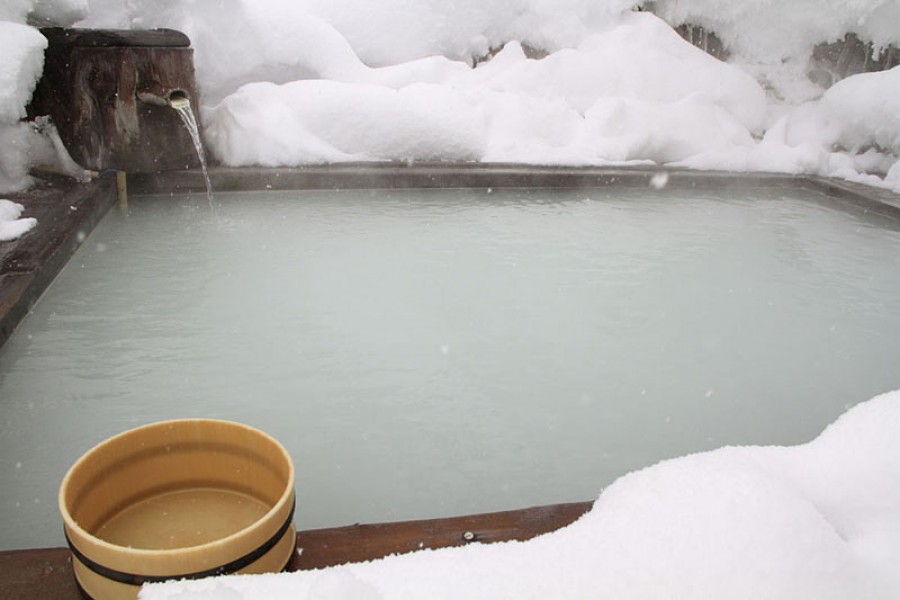
Noji Onsen
Noji Onsen is a beautifully scenic onsen resort in Adatara mountains. It is especially breathtaking when the outdoor baths, and their cloudy white waters, are surrounded by stunning snowy landscapes in winter.
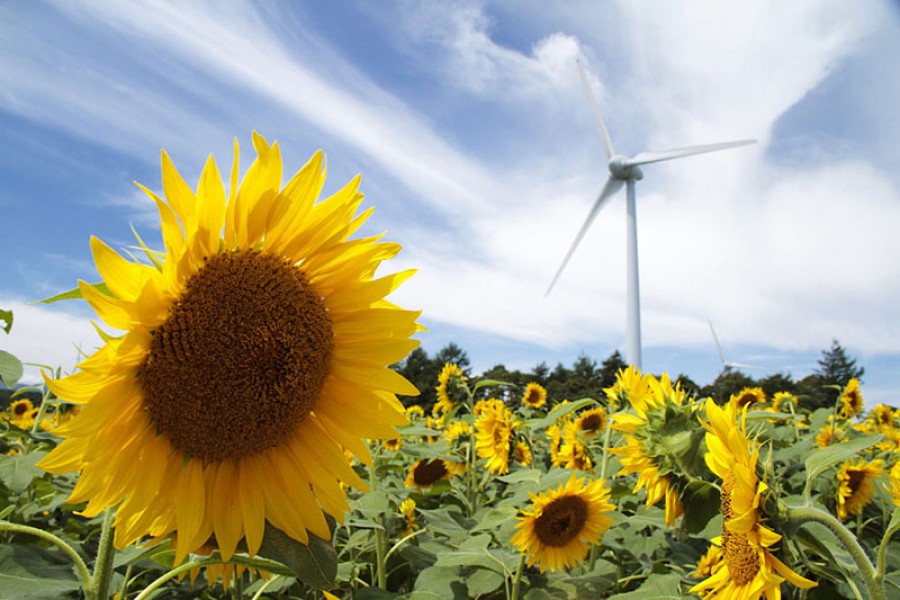
These windy highlands are located at the plateau summit of Mt. Aizu-Nunobiki. It’s location to the south of Lake Inawashiro provides ample breeze to power the 33 windmills that stand majestically atop the highland plateau. Nunobiki Kogen Wind Farm is one of Japan's largest wind farms. It's location at an altitude of about 1,000 meters, makes for a truly fantastic view of the surrounding scenery.
From early August to early September, visitors can enjoy amazing vistas of the beautiful himawari batake (sunflower fields). The sunflowers here are planted at 3 different intervals, meaning that visitors can enjoy seeing them throughout the summer months.
Sunflowers aren’t all that Koriyama Nunobiki Kaze-no-Kogen has to offer flower lovers: - from August to September - you can see cosmos blooming. Of course, visitors are always greeted with superb views of Lake Inawashiro and Mt. Bandai.
There are walking courses along the plateau, so visitors can explore the area and snap some great photos. One really amazing photo spot can be found at the observatory. Depending on the timing of your visit, you might be able to purchase some local vegetables at temporary stalls. We recommend trying the region’s famous Nunobiki Plateau daikon radish.
| Website | http://www.kanko-koriyama.gr.jp/tourism/detail1-0-12.html(Japanese) |
|---|---|
| Contact | Koriyama City Tourism Association (+81) 24-924-2621 |
| Best Season |
|
| Opening Hours | The wind farm is closed from Dec. to late Apr. due to heavy snow. |
| Parking | Parking spaces available for 7 buses, 92 cars and 2 cars with wheelchairs |
| Entrance Fee | Free |
| Accommodation details | Pets: Permitted |
| Access | Akatsu, Konan-machi, Koriyama City, Fukushima Pref. 963-1631 View directions |
|---|---|
| Getting there | By Car: 45 min from Koriyama Minami I.C. exit off the Tohoku Expressway By Train: 60 min by taxi or rental car from Koriyama Station (JR Tohoku Line) |

Noji Onsen is a beautifully scenic onsen resort in Adatara mountains. It is especially breathtaking when the outdoor baths, and their cloudy white waters, are surrounded by stunning snowy landscapes in winter.

Azuma Orchard is located along the Fruit Line (a road in Fukushima City which is surrounded by orchards). Here visitors can pick their own fruit, such as cherries from early June, peaches from mid-July, nashi (Japanese pears) and grapes from early September, and apples from October.The grounds of Azuma Orchard include a shop which has been recently renovated. Visitors can also enjoy soft-serve ice-cream in a range of seasonal flavors.
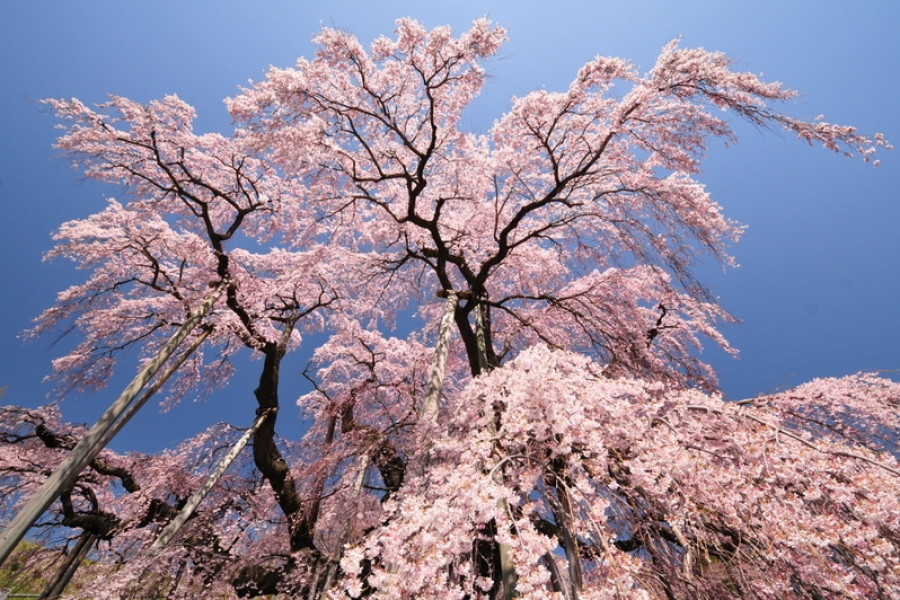
Miharu is a small town in central Fukushima Prefecture. The town’s name means “three springs” and it is easy to see how it got such a name. With cherry, plum, and peach trees blossoming in spectacular displays every spring, it is almost as if spring has tripled! But the most famous of the trees in Miharu is the Miharu Takizakura tree, which is a nationally recognized Natural Monument.Over ten centuries old, the beautiful Miharu Takizakura is a flowering cherry tree that spreads out in all directions and makes for a breathtaking vista. The cascading blankets of blossoms are how this tree got the name takizakura, or “waterfall cherry tree.” It is even one of the “three great cherry trees” of Japan (along with Usuzumizakura in Gifu and the Jindaizakura in Yamanashi Prefecture).Miharu Takizakura sits in a sakura hollow in order to protect it from the elements while providing excellent drainage. The heavy boughs of the tree are supported by wooden beams and lend to its elegant form. The Miharu Takizakura begins blooming from mid-April. During the day the sight is whimsical, but visit in the evening and you’ll be treated to an almost haunting beauty as the tree is illuminated.Aside from this huge cherry tree (over 12 meters tall and 18 to 22 meters in spread), the area is also blessed with various wildflowers, including cherry and rapeseed flowers. But, of course, the Miharu Takizakura is what the annual 200,000 visitors are there to see. The view from the base of the sakura is considered to be the most beautiful and the Miharu Takizakura often ranks as the best sakura tree in all of Japan.
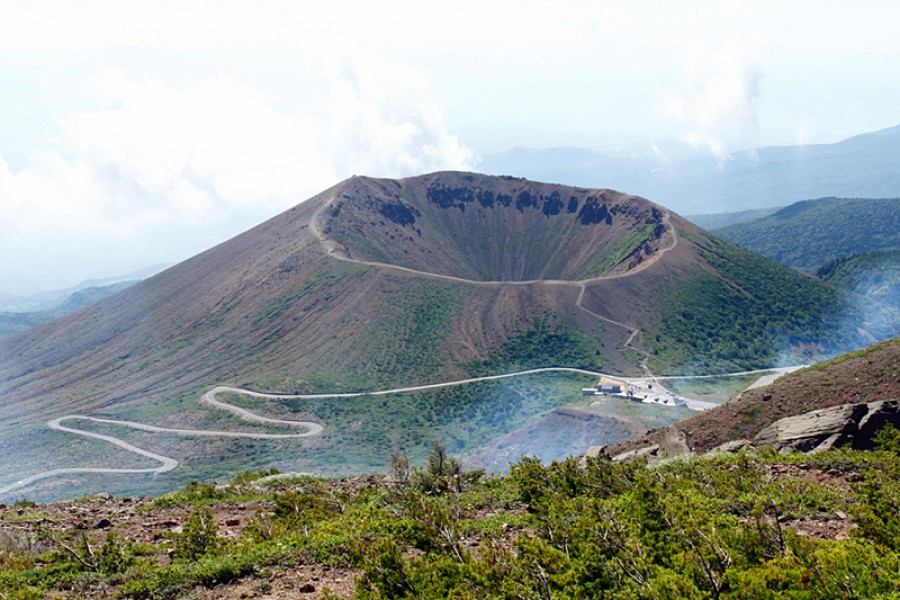
There is a special bus running from Fukushima Station to the Jododaira plateau while the mountain is open. Please visit the Jododaira Sky Access page for more details.Every year in spring, as the snow melts away, it leaves behind the shape of a giant white rabbit on the side of Mt. Azuma-Kofuji. This is called the “seeding rabbit”, and it signals to the people of Fukushima that the farming season has come.From April to November each year, you can experience the beauty of the awe-inspiring natural landscape of Mt. Azuma-Kofuji.Mt. Azuma-Kofuji is an active volcano with an appealing symmetry to it and a soft conical shape; because of these classic features, it was named Kofuji ('little Fuji'), after the iconic Japanese mountain.Thanks to its volcanic ground, the area has given birth to many nearby onsen areas perfect for relaxing, such as Tsuchiyu Onsen and Takayu Onsen.Mt. Azuma-Kofuji is a great destination for those who decide to drive through the area as the Bandai-Azuma Skyline happens to pass just below the crater of Mt. Azuma-Kofuji. Along the roadway is the Jododaira Visitor Center, which offers visitors a place to park, rest up, get a snack, and maybe even buy souvenirs. It is the perfect spot to take a break and explore one of the many short hiking routes to stretch out your muscles after a long car ride. From there, it is just a short hike up to the crater, and there are plenty of other great trails. Circle the crater of Mt. Azuma-Kofuji on a relaxed 40-minute walk and—if you are lucky—enjoy gorgeous views of Fukushima City, Mt. Bandai, and the Urabandai area. But do watch your step as the ground can be uneven and even slippery on grey days. The mountain is open from spring to autumn every year.
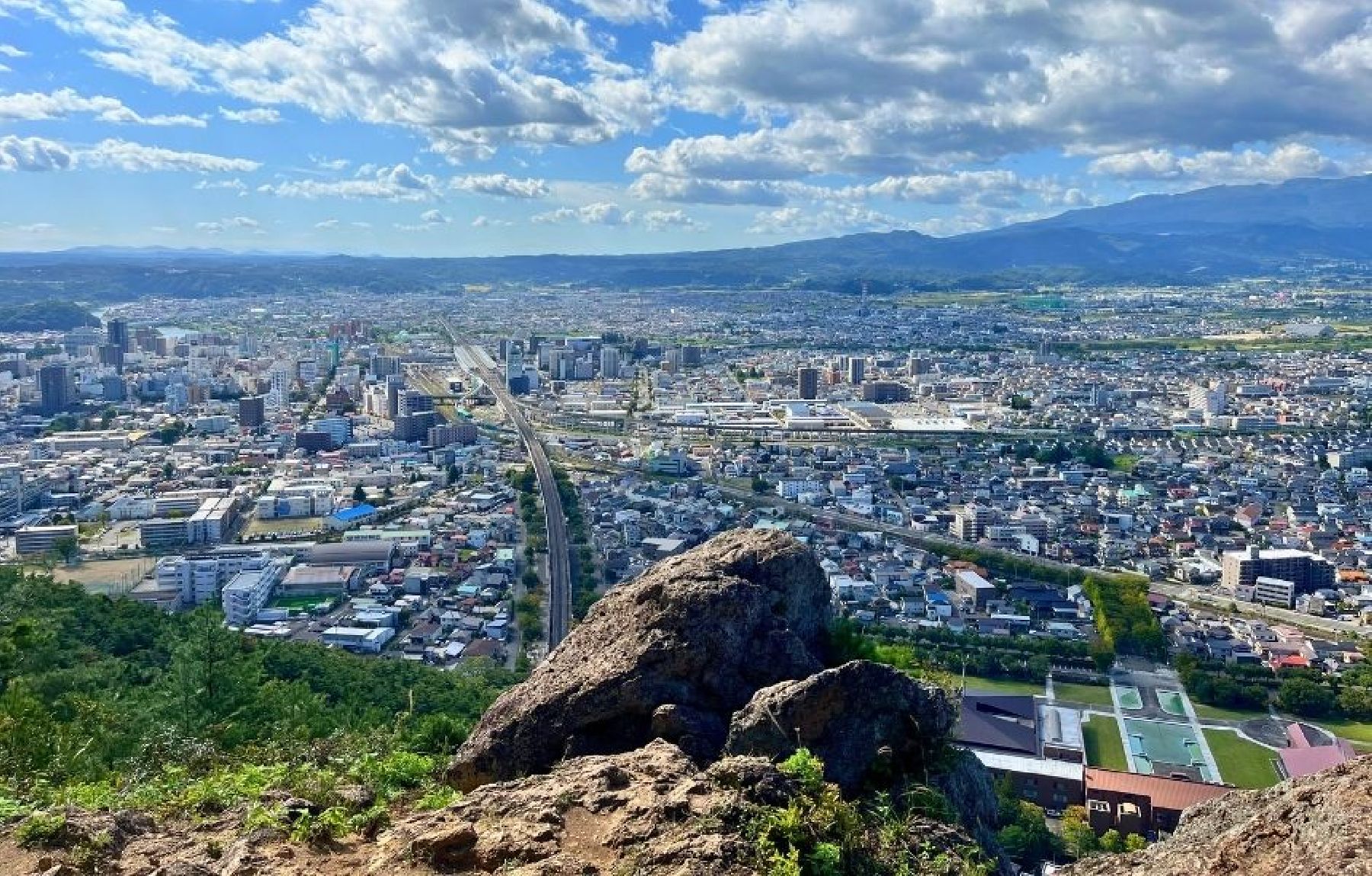
Mt. Shinobu, with a total altitude of 275 meters, is one of the most recognisable landmarks of Fukushima City. It is estimated that it formed about 500,000 years ago when the Fukushima basin caved in and Mt. Shinobu became an isolated hill, which later became the object of multiple local poems, stories, and legends.Visitors can hike up Mt. Shinobu for unobstructed views of the cityscape. Hikers of all levels can try climbing Mt. Shinobu, as its peak can be reached in a few hours and many parts of it can be reached by car.Each year in April, there is a spring festival with cherry blossom night illuminations that attract hordes of visitors. Summer and autumn are also great times to follow the hiking routes on Mt. Shinobu.A spiritual power spot for locals, Haguro Shrine can be found at the top of the central peak, where there is also a giant straw sandal that weighs about 2 tons and is 12 meters in length and is believed to be among the biggest in Japan. The sandal is paraded along Fukushima City each year in August during the Waraji Festival. Also in Mt. Shinobu, you can find the Shinobuyama Neko Inari Jinja (‘cat shrine’), and the Gokoku Shrine, along with several parks.For stunning views of the city, including the Shinkansen bullet train tracks, head to the Karasugasaki Observation Deck on the western side. Located nearby are the Fukushima Prefectural Museum of Art and the Fukushima Prefectural Library.
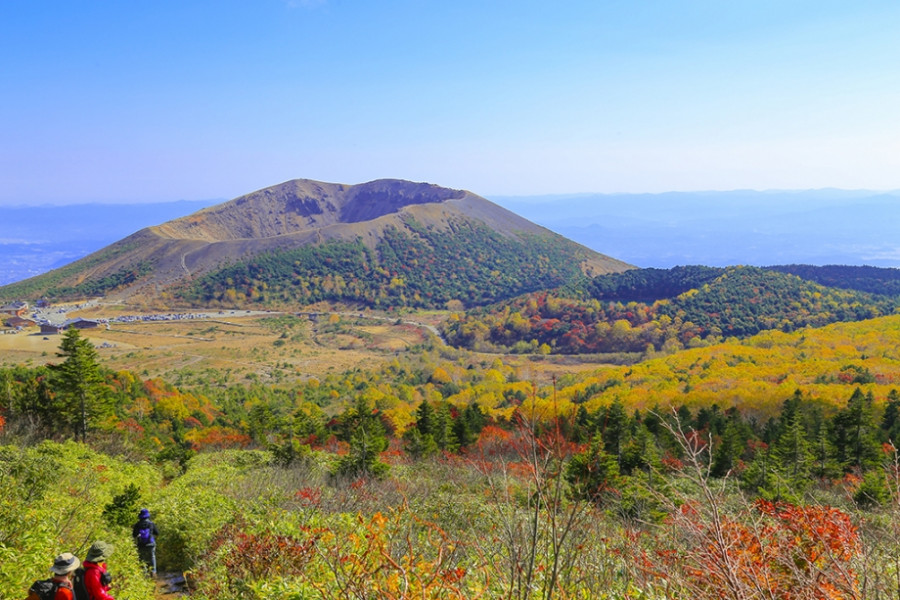
There is a special bus running from Fukushima Station to the Jododaira plateau while the mountain is open. Please visit the Jododaira Sky Access page for more details.Jododaira Visitor Center, located at an altitude of 1500 m, stands partway along the Bandai-Azuma Skyline sightseeing road. Jododaira acts as a base to spend the day hiking nearby mountain routes, including Mt. Higashi-Azuma (1,975 m) and Mt. Issaikyo (1,949 m). For those who don’t fancy a long hike, the 1-hour round trip walk up and around the crater at Mt. Azuma Kofuji (1,705 m) is perfect, as it is a very short walk from Jododaira Visitor Center. The Azuma mountains are all totally unique, and are great places to enjoy local flora and fauna. If hiking in this area, please be mindful that the altitude reaches close to 2000 m, so make sure to take equipment necessary in the event of a sudden weather change. The Jododaira area is also prone to high volcanic gas levels, so it is a good idea to check whether the area is open to visitors before making the drive up the mountain roads.
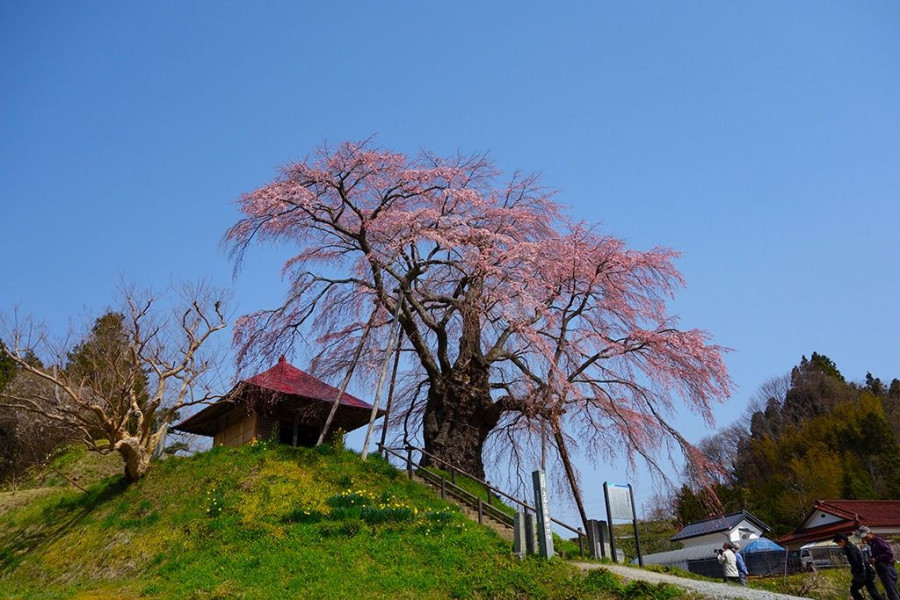
This tree is located on the grounds of a temple dedicated to the Buddhist deity Acala (known as Fudo Myoo in Japan), and is thus known locally as the Fudo Cherry Blossoms. The tree is about 350 years old and is considered to be a descendant of the Miharu Takizakura, a famous cherry tree located in nearby Miharu Town. Photography tip: Angle your camera so you capture both the cherry blossoms and the yellow canola flowers.
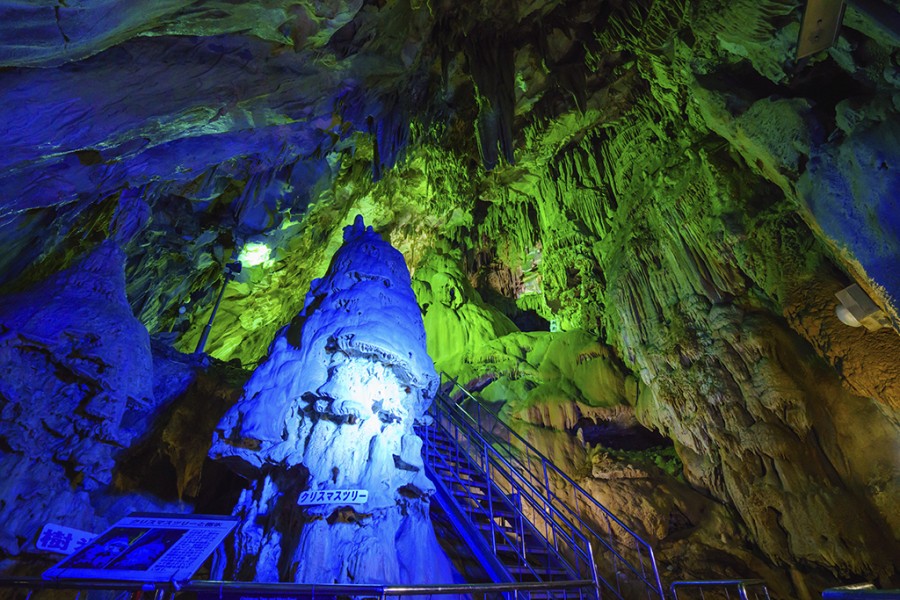
A world of mystical beauty created over millions of years, Abukuma Cave is said to have the greatest variety and the largest number of stalactites in the whole of Asia. It takes about an hour to explore the inner world of the cave and the terrain is easy to navigate on foot.Abukuma Cave is a limestone cave that was discovered in 1969. Inside, visitors can walk the 600-meter-long path to explore and view the beautiful cave formations. Visitors can’t help but be impressed by the beauty of these natural creations formed over the course of 80 million years. The largest hall in the cave, called Takine Goten (Takine Hall), and Tsuki no Sekai (The Moon World), is illuminated with dramatic stage lighting and is particularly impressive.Also not to be missed are the rare cave formations called boxwork, you can identify them by their unique shape; thin blades of minerals coming off the walls and ceilings forming a honeycomb or box-like pattern. Abukuma Cave is the only cave in Japan with boxwork that is open to the public. Another notable stop along the cave path is the Christmas Tree and Silver Frost; both are impressive stalagmites that resemble festive holiday trees. The Christmas Tree is over two meters tall and said to be the largest example in all of Asia.There is an additional thrilling adventure course; experience crawling through narrow passages and climbing a ladder to spectacular views over the cave! This 120-meter-long course runs parallel to the main passage, but please note that visitors may have to crawl on their hands and knees at times.When you have finished exploring the mysterious depths and come back to the surface you can find plenty of restaurants and souvenir shops. Visit from mid-June to July to see the neighbouring hillside covered in 50,000 lavender plants.